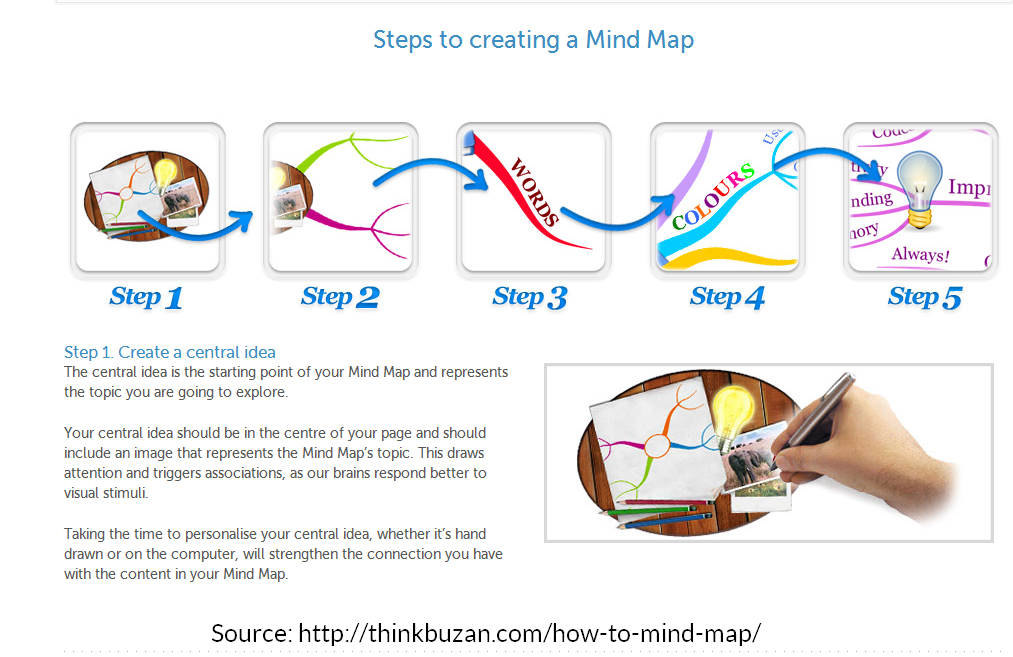How to Mind Map
Learn to capture information and ideas with the technique that is helping over 250 million people worldwide to be more organised, productive and creative.
Mind Mapping is a method of capturing information created by international speaker and bestselling author, Tony Buzan. It is proven to boost your productivity, creativity and memory.
This versatile technique is already used by over 250 million people worldwide for a variety of tasks including brainstorming, identifying new opportunities, organizing, managing projects, teaching, studying, communicating information and much more.
What is a Mind Map?
A Mind Map is a visual thinking tool that can be applied to all cognitive functions, especially memory, learning, creativity and analysis. Mind Mapping is a process that involves a distinct combination of imagery, colour and visual-spatial arrangement. The technique maps out your thoughts using keywords that trigger associations in the brain to spark further ideas.
Mind Maps can be drawn by hand or using software such as iMindMap. When creating a Mind Map, there are several elements to consider including the map’s central image, branches, colours, keywords and images. Let’s take a look at these now…
Steps to creating a Mind Map
Step 1. Create a central idea
The central idea is the starting point of your Mind Map and represents the topic you are going to explore.
Your central idea should be in the centre of your page and should include an image that represents the Mind Map’s topic. This draws attention and triggers associations, as our brains respond better to visual stimuli.
Taking the time to personalize your central idea, whether it’s hand drawn or on the computer, will strengthen the connection you have with the content in your Mind Map.
Step 2. Add branches to your map
The next step to get your creative juices flowing is to add branches. The main branches which flow from the central image are the key themes. You can explore each theme or main branch in greater depth by adding child branches.
The beauty of the Mind Map is that you can continually add new branches and you’re not restricted to just a few options. Remember, the structure of your Mind Map will come naturally as you add more ideas and your brain freely draws new associations from the different concepts.
Step 3. Add Keywords
When you add a branch to your Mind Map, you will need to include a key idea. An important principle of Mind Mapping is using one word per branch. Keeping to one word sparks off a greater number of associations compared to using multiple words or phrases.
For example, if you include ‘Birthday Party’ on a branch, you are restricted to just aspects of the party. However, if you simply use the keyword ‘Birthday’, you can radiate out and explore the keyword, party, but also a wide variety of different keywords such as presents, cake etc.
One word per branch also works well for chunking information into core topics and themes. The use of keywords triggers connections in your brain and allows you to remember a larger quantity of information. This is supported by Farrand, Hussain and Hennessey (2002) who found that medical students who adopted Mind Mapping experienced a 10% increase in their long-term memory of factual information.
Step 4. Colour code your branches
Mind Mapping encourages whole brain thinking as it brings together a wide range of cortical skills from logical and numerical to creative and special.
The overlap of such skills makes your brain more synergetic and maintains your brain’s optimal working level. Keeping these cortical skills isolated from one another does not help brain development which the Mind Map seeks to do.
One example of whole brain thinking is colour coding your Mind Maps. Colour coding links the visual with the logical and helps your brain to create mental shortcuts. The code allows you to categorize, highlight, analyse information and identify more connections which would not have previously been discovered.
Colours also make images more appealing and engaging compared to plain, monochromatic images.
Step 5. Include Images
Images have the power to convey much more information than a word, sentence or even an essay. They are processed instantly by the brain and act as visual stimuli to recall information. Better yet, images are a universal language which can overcome any language barrier.
We are intrinsically taught to process images from a young age. According to Margulies (1991), before children learn a language, they visualize pictures in their minds which are linked to concepts. For this reason, Mind Maps maximize the powerful potential of imagery. [From: Thinkbuzan.com]
A very interesting resource is now available online for learning how to mindmap or improving your mind mapping skills.
It’s free and no sign-up is necessary.
Published by ThinkBuzan, this E-Learning Program is very clear and intuitive.
With various examples, short videos and concise explanations, this program is essentially an introduction to the science behind Mind Mapping, its fundamental principles and a Guide to creating Mind Maps.
The following free additional and useful contents are also available within the website:
- A Mindmap Gallery with more than 40 high quality mindmaps
- A downloadable 85 page document about the scientific facts behind the technique
[From: Visual-mapping.com]
Now Watch These Videos:
How To Have Better Creative Thinking ; TIME 3:35
Tony Buzan (Mind Mapping) – How To Make the Most of Your Creative Mind : Learning Technologies 2013 ; TIME 55:25
The Power of a Mind to Map: Tony Buzan at TEDxSquareMile ; TIME 19:35
If you like this story, CLICK HERE to join the tribe of success-minded people just like you. You will love our weekly quick summaries of top stories, talks, books, movies, music and more with handy downloadable guides, cheat sheets, cliffs notes and quote books.





















